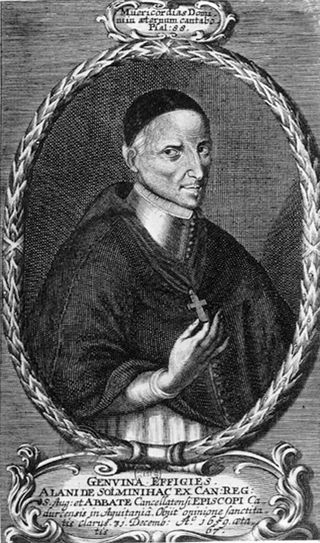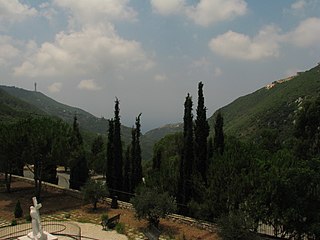
Charbel Makhlouf, O.L.M., born Youssef Antoun Makhlouf and venerated as Saint Charbel, was a Maronite monk and priest from modern-day Lebanon. During his life, he obtained a wide reputation for holiness, and for his ability to unite Christians, Muslims and Druze.

Nimatullah Kassab, also known as "Al-Hardini" in reference to his birth village, was a Lebanese monk, priest and scholar of the Maronite Church. He has been declared a saint by the Catholic Church.

Johannes Ludovicus Paquay, also known as Valentinus, was a Belgian Roman Catholic priest and a professed member from the Order of Friars Minor. He was a popular confessor and noted preacher while serving in various leadership positions in the house he was stationed in; he was also known for his popular devotion to the Eucharist and the Sacred Heart and promoted these devotions to the faithful and to his conferees alike.

Szymon of Lipnica was a Polish catholic priest and a professed member from the Order of Friars Minor. He became a sought after and noted preacher and took as his preaching inspiration Saint Bernardine of Siena and also was a strong proponent of popular devotions that he worked to spread.

Pius of Saint Aloysius was an Italian Roman Catholic professed cleric from the Passionists. He died before he could receive his ordination to the priesthood but in his short life managed to captivate people around him for his strong dedication to his order's charism and his deep faith.

Alain de Solminihac was a French Roman Catholic religious reformer and served as the Bishop of Cahors from 1636 until his death.

Stanisław Kazimierczyk was a Polish Catholic priest and a professed member of the Canons Regular of the Lateran. He became noted for his ardent devotions to both the Eucharist and to his personal patron saint, Stanislaus of Szczepanów, as well as for his charitable dedication to the ill and poor of Kraków.
Gaetana Sterni was an Italian Roman Catholic professed religious and the founder of the Sisters of Divine Will. Sterni's life became marred due to the deaths of close relations including her husband and sole child which prompted her to look towards an apostolate to aid others and to ease others' sufferings. The order she founded was dedicated to total consecration to Jesus Christ and to an active apostolate of evangelic zeal.

Claudio Granzotto was an Italian professed religious from the Order of Friars Minor and a noted sculptor. Granzotto's works were a conduit for his religious expression and are reflective of his dedication to use sculpting to evangelize to others.
Giuseppe Oddi was an Italian Roman Catholic professed religious - though not a priest - of the Franciscan Order of Friars Minor Capuchin. He felt drawn to religious life after his adolescence and was resolved to become a Franciscan upon seeing the example that Mariano da Roccacasale set. Upon his profession of vows he assumed the religious name of "Diego da Vallinfreda". Oddi was beatified - alongside Mariano da Roccacasale - when Pope John Paul II presided over the late Franciscans' beatification on 3 October 1999.
Tomasa Ortiz Real was a Spanish Roman Catholic professed religious who founded the Salesian Sisters of the Sacred Heart and assumed the religious name of "Piedad of the Cross" upon becoming a nun.

Artemide Zatti was an Italian Roman Catholic professed religious of the Salesians of Don Bosco and a noted pharmacist who emigrated to Argentina in 1897. Zatti became a professed Salesian in 1911 and became well known for his ardent faith and commitment to the sick. He was made a Saint on October 9, 2022 in the Catholic Church.

Khalīl al-Haddād, OFM Cap., also known as Ya'Qūb from Ghazīr, was a Lebanese Catholic priest and Capuchin friar. He was the founder of the Franciscan Sisters of the Cross, and a noted preacher and founder of various orphanages and schools across Lebanon. Presidents of the state honored him with various awards, while the populace compared him to the likes of Vincent de Paul and John Bosco.
Elisabetta Maria Satellico – in religious Maria Crocifissa – was an Italian Roman Catholic professed religious from the Poor Clares who served as her convent's abbess.

María del Carmen González-Ramos García-Prieto de Muñoz, also known by her religious name María del Carmen of the Child Jesus, was a Spanish Roman Catholic professed religious and the founder of the Franciscan Sisters of the Sacred Hearts. She married in mid-1857 – against her parents' advice – to a brash and dissolute husband and secured his repentance not too long before his death.

The Martyrs of Natal were a group of 30 Roman Catholic people of Colonial Brazil – two of them priests – killed in the northern part of the colony in massacres that a large group of Dutch Calvinists led. One priest was a Colonial Brazilian Jesuit missionary, while the other priest was an evangelizer himself. The others were all lay Catholics, most of them anonymous members of the Church, some of them children.

Leonard Melki – born Yūsuf Habīb Melkī and in religious Līūnār from B'abdāt – was a Roman Catholic priest and a professed member of the Order of Friars Minor Capuchin. His name is often Romanized in various texts. Melki became a priest before serving as a preacher and teacher in different stations of the Mission of Armenia and Mesopotamia of the Capuchin Order. He eventually became the principal of the school of the Capuchin Order in Mardin where he taught the French language and music. He was later arrested and marched to the Sheikhan Caves in the deserts outside Mardin. On June 11, 1915, as part of a deportation convoy of Armenian and Assyrian Christians; including Catholics, Miaphysite Orthodox, and Protestants, they were massacred at the Sheikhan Caves by a combined force of the Ottoman Army and Ottoman Gendarmerie, during the Armenian and Assyrian Genocides ordered by Ottoman Interior Minister Talat Pasha.

Colomba Matylda Gabriel - in religious Janina - was a Ukrainian Roman Catholic professed religious and the founder of the Benedictine Sisters of Charity. Gabriel studied under the Order of Saint Benedict in Lviv and later became a Benedictine herself while dedicating herself to teaching at her old school before she was forced to relocate to Rome in 1900 where she founded her order and joined a Benedictine branch there.
Juan Bautista and Jacinto de los Ángeles were Mexican Roman Catholics. The pair were both instructed to protect moral practices in their town and to ensure that the faith was safeguarded in the face of pagan and tribal beliefs and practices. But this put them into conflict with some locals who decided to hunt them down and kill them after the pair interrupted a ritual and confiscated their possessions. The two men were slain after being captured in a local Dominican convent and after having professed their faith to their attackers.

Kfifan is a village in the Batroun District of the North Governorate in Lebanon.















